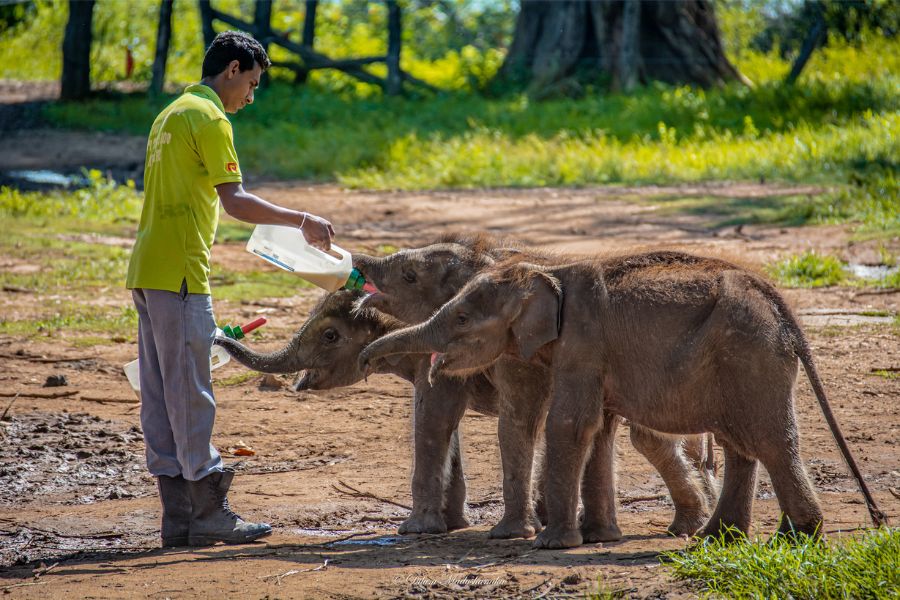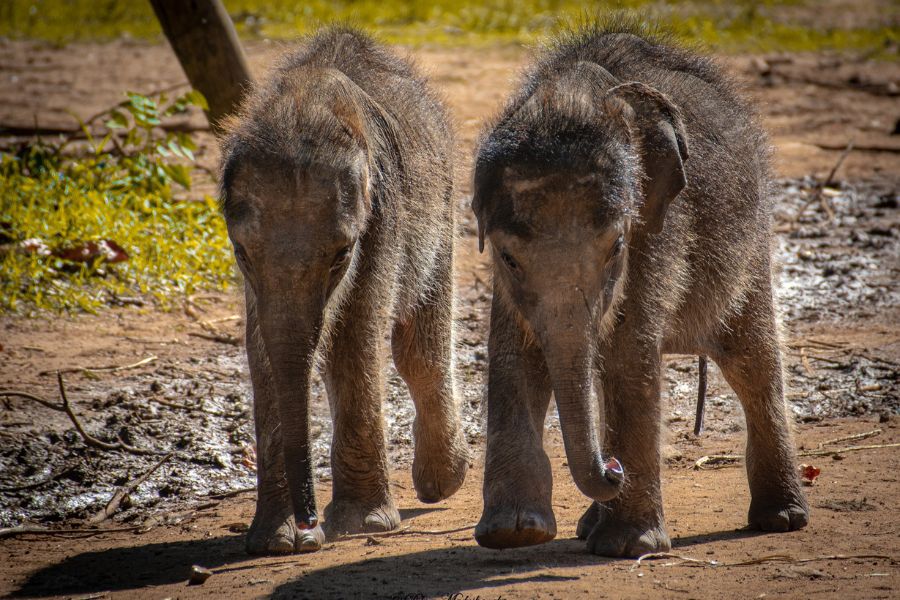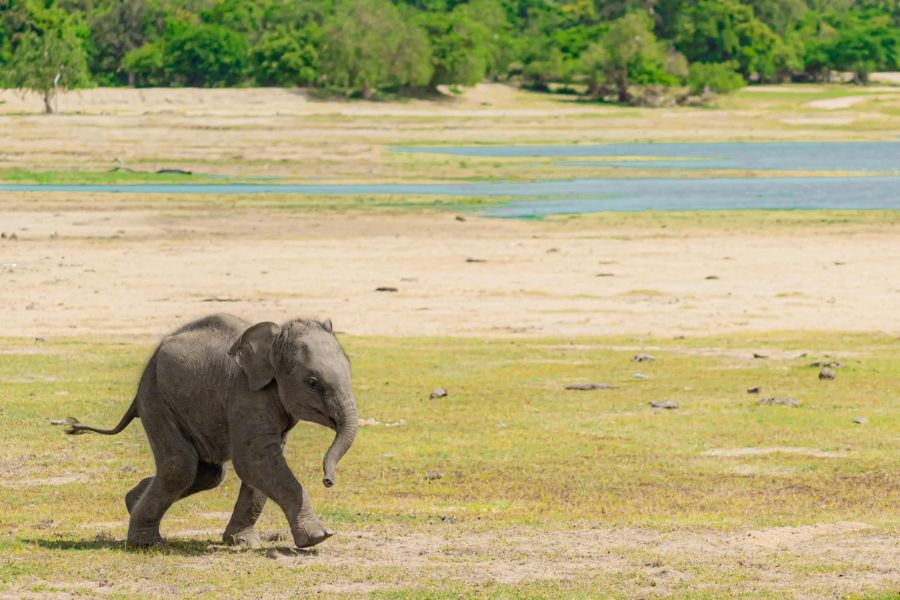Rehabilitation of Wild Elephant Calves in Sri Lanka: Bridging Conservation and Eco-Tourism
Rehabilitation of Wild Elephant Calves in Sri Lanka: Bridging Conservation and Eco-Tourism
It was a serene golden evening in Udawalawe National Park, where the tall grasses rustled gently in the breeze. As the sun cast its warm glow over the landscape, a small herd of elephants, silhouetted against the horizon, moved gracefully through the grassland.
But among them, one calf stumbled—alone, vulnerable, and orphaned—left to face the world without his mother. This scene is tragically becoming common in Sri Lanka, a consequence of the long-standing human-elephant conflict (HEC).
Sri Lanka's elephant population, numbering around 6,000, faces a precarious future. Over the years, human settlements have expanded, encroaching on traditional elephant habitats and leading to intense clashes.
While Sri Lankan elephants are revered in religious and cultural traditions, symbolizing strength, wisdom, and prosperity, they are increasingly seen as a threat by farmers whose livelihoods are at stake. This tension leads to devastating consequences for both humans and elephants, often leaving calves orphaned and in need of urgent care.

The Vital Role of the Elephant Transit Home (ETH)
In the heart of Udawalawe National Park lies a sanctuary for these orphaned calves: the Elephant Transit Home (ETH). Established in 1995, the ETH is dedicated to rescuing, rehabilitating, and reintroducing wild elephant calves back into their natural habitats. The rehabilitation process is intricate and science-based, ensuring that calves retain their wild instincts. Here, the calves receive medical care, proper nourishment, and the social interactions needed to prepare them for their release back into the wild.
The statistics are telling: since its inception, the ETH has successfully rehabilitated and released over 300 elephants, a monumental achievement in the field of conservation . Each calf undergoes a carefully monitored journey, staying at the center until they are deemed capable of reintegrating into the wild.
During this time, minimal human interaction is prioritized to ensure that they remain wild and self-sufficient upon release.
Human-Elephant Conflict: A National Crisis
Sri Lanka experiences one of the highest levels of human-elephant conflict (HEC) in the world. The conflict arises from the overlapping needs of humans and elephants—both require land for food and space to thrive. But with 70% of elephant habitats located outside protected areas , the chances of encounters with human settlements are frequent, and often violent.
Each year, approximately 100-150 elephants are killed due to HEC, and around 50 people lose their lives in these clashes . As elephants wander into farmlands, they destroy crops and occasionally homes, prompting farmers to retaliate by setting traps or even shooting elephants.
The calves left behind in these confrontations are often found roaming alone, unable to fend for themselves without the guidance and protection of their mothers. This is where the ETH steps in, offering a second chance to these vulnerable young elephants.

Eco-Tourism: A Pathway to Coexistence
Amidst this backdrop of conflict, eco-tourism offers a promising solution, not only as a tool for conservation but as a means to foster coexistence between humans and elephants. At Mahoora Tented Safari Camps in Udawalawe, guests are immersed in the wilderness while gaining insight into the importance of conservation. The trained naturalists at Mahoora share stories of the human-elephant conflict, shedding light on the intricate balance between conservation efforts and the livelihoods of rural communities.
By choosing eco-friendly accommodations like Mahoora Tented Camps, guests directly contribute to the efforts at Udawalawe’s Elephant Transit Home. By visiting the ETH as a Mahoora Guest portion of the revenue generated from eco-tourism is channeled into these conservation projects, including the care and rehabilitation of orphaned elephant calves.
This model benefits both wildlife and local communities by fostering a culture of stewardship and reducing the incidences of conflict. Guests leave not only with memories of majestic elephants but with a deeper understanding of the fragile relationship between humans and wildlife in Sri Lanka.
Eco-tourism ventures like Mahoora Tented Camps also promote community-based conservation initiatives. By engaging with locals, these initiatives demonstrate that protecting elephants can bring economic benefits, transforming them from pests into valuable assets. This shift in perspective is essential for long-term coexistence. Also innovative projects like the Buttala - GonaganAra - HEC Mitigation projects by the Mahoora Team bring a whole new perspective to these concepts.
Elephants in Sri Lankan Culture: A Symbolic and Practical Dilemma
Elephants have long been a part of Sri Lanka’s cultural and religious fabric. They play a prominent role - though highly controversial- in Buddhist processions such as the Esala Perahera in Kandy, where elephants are adorned in ceremonial garb and paraded through the streets. Historically, they have also been symbols of power, wealth, and spiritual significance.
Yet, the cultural reverence for elephants is juxtaposed with the harsh realities of HEC. The very communities that hold elephants in such high esteem are often the same ones forced to deal with the devastating consequences of crop raids and property damage. This paradox reflects the challenges of modern conservation in a rapidly developing country.
At Mahoora Tented Safari Camps, guests learn not only about the scientific efforts to protect elephants but also about the cultural significance of these animals. By fostering an understanding of both aspects, eco-tourism helps bridge the gap between conservation and local traditions.
A Future of Hope: Eco-Tourism as a Solution
The rehabilitation of wild elephant calves is about more than just preserving the species—it is about finding a sustainable way for humans and elephants to coexist. Through eco-tourism, projects like the ETH in Udawalawe National Park are not only saving individual elephants but contributing to a broader vision of harmony between humans and nature.
Mahoora Tented Safari Camps provide a model for responsible tourism that empowers both guests and local communities to be part of the solution. As guests leave with unforgettable experiences, they also become advocates for conservation, spreading the message of coexistence far beyond Sri Lanka’s borders.
The future of Sri Lanka’s wild elephants depends on continued efforts in rehabilitation, conservation, and education.
Through the collaboration of eco-tourism ventures, conservationists, and local communities, there is hope that future generations will witness the beauty of elephants roaming free, not just in Udawalawe, but across the entirety of Sri Lanka’s wild landscapes.

References:
- Elephant Transit Home. Department of Wildlife Conservation. Available at: http://www.dwc.gov.lk
- Sri Lanka’s Elephant Crisis: Human-Elephant Conflict. World Wildlife Fund. Available at: https://www.worldwildlife.org
- Mahoora Safari Camps - Unawalawe. Eco Team Sri Lanka. Available at: https://www.mahoora.com
- Human-Elephant Conflict in Sri Lanka: A Review of Causes and Mitigation Strategies. ResearchGate. Available at: https://www.researchgate.net

